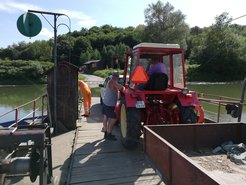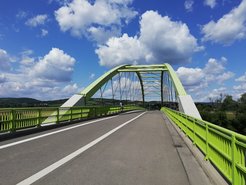Crossing the San: Bridges, Cable Ferries, and Everyday Cross-River Mobility in Southeastern Poland
For years, the inhabitants of the villages situated along the River San in Southeastern Poland were largely left to find ways to cross the river by themselves, as the Polish state’s political and economic involvement in a part of the country known as “Polska B” was rather limited. In the last decade, however, the area has seen the construction of two new bridges, which not only have affected the everyday mobility practices and social interactions of the populations serviced by them, but have also led to an upsurge in discussions, desires, and fantasies – as well as fears and contestations – regarding the construction of more bridges. In turn, this “construction talk” has boosted the “infrastructural hope” of the inhabitants of those villages that are either not connected with the opposite bank of the San, or are connected by means of suspension footbridges or river ferries.
Indeed, for many inhabitants, ferries are the fastest, shortest, and – in some cases – only way to commute back and forth to work, take children to school, shop at the local convenience store, or take heavy agricultural machinery to fields situated across the San. Yet, the ferries’ mobility is contingent upon a series of environmental and climatic factors, which means that they operate only for a few months every year. For example, ice and floe in the winter months make their crossing the river impossible, whereas low water levels in summer and early autumn and high water levels in late autumn and spring often mean that ferries have to stop operating for several days or weeks at a time. Additionally, technical parameters, political decisions, financial considerations, as well as quotidian issues related to the everyday lives of the ferrymen also affect the duration and the frequency of the service.
Hence, the replacement of these ferries with bridges has been a long-standing demand of the majority of the local population, but, given that ferries are seen as a characteristic element of the landscape of the San and a significant tourist attraction, their replacement by concrete bridges makes individuals who have invested in sustainable tourism uneasy. As a result, debates have arisen on whether the area can gain more from modern infrastructure – represented by concrete bridges – or from pre-modern infrastructure – ferries and footbridges –, essentially presenting the bridge as a “spectre” that haunts the discussions and the everyday lives of the local population, simultaneously feeding the infrastructural hopes of some and threatening the business of others. Yet, not all ferry crossings have the same chance of being replaced by bridges, for such a development depends less on the needs of the local population or the number of passengers that they carry on any given day and more on the category that the public road that they operate on falls under.
Drawing on ethnographic fieldwork conducted in the area in summer 2019, this project examines the infrastructural inequality that characterises Poland in general and the area under examination in particular. To that end, by taking into account the rather strict hierarchical framework that divides Poland’s road network into several categories, it brings questions of “infrastructural hierarchy” into the debate and argues that the construction of infrastructure in Poland’s periphery is closely interwoven with the institutional knowledge and personal connections – as well as ambitions and self-interest – of local public servants and bureaucrats. It in this sense that the project sheds light into the processes behind the construction of large infrastructure projects by focusing on policy-making in the periphery and highlighting the agency of local state functionaries.



